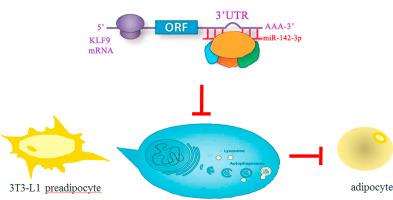Molecular and Cellular Endocrinology ( IF 4.1 ) Pub Date : 2020-09-07 , DOI: 10.1016/j.mce.2020.111028 Ziwen Wei 1 , Xiaoli Qin 2 , Xiaojie Kang 2 , Haixia Zhou 2 , Shaodan Wang 2 , Dong Wei 2

|
Background
MiR-142-3p has been shown to be suppressed in obese patients, while the underlying regulatory mechanism is unclear.
Methods
Body shape indexes as well as peripheral blood for biochemical parameter analysis were obtained from obese and healthy subjects. When 3T3-L1 cells were induced to differentiate, miR-142-3p expression was detected by quantitative real-time polymerase chain reaction (qRT-PCR). The effects of miR-142-3p on triglyceride (TG) and adipogenic differentiation-related genes during the adipogenic differentiation of 3T3-L1 cells were detected by transfection, Oil Red O staining, and Western blot. The targeting relationship between miR-142-3p and Krueppel-like transcription factor 9 (KLF9) was verified by TargetScan and dual-luciferase experiment. The specific regulatory effects of miR-142-3p on cell adipogenic differentiation and autophagy were analyzed by rescue experiments. In vivo experiments further validated the results of in vitro experiments through obese mouse models.
Results
Obesity-marked biochemical indicators increased whereas high density lipoprotein and miR-142-3p decreased in obese patients. The content of miR-142-3p gradually decreased with cell lipid differentiation. Overexpression of miR-142-3p reduced TG deposition in cells by down-regulating lipid formation and fatty acid synthesis genes and up-regulating fatty acid oxidation genes. KLF9 targeting miR-142-3p was suppressed by miR-142-3p. KLF9 overexpression partially reversed the inhibitory effect of miR-142-3p mimic on adipogenic differentiation and the expressions of autophagy related-genes in 3T3-L1 cells. MiR-142-3p overexpression also inhibited fat cell differentiation and autophagy in obese mice.
Conclusion
Overexpressed miR-142-3p inhibited adipogenic differentiation and autophagy through targeting KLF9.
中文翻译:

通过靶向KLF9,MiR-142-3p可抑制肥胖中的脂肪形成分化和自噬。
背景
已证明在肥胖患者中MiR-142-3p被抑制,而潜在的调节机制尚不清楚。
方法
从肥胖和健康受试者获得身体形状指数以及用于生化参数分析的外周血。当诱导3T3-L1细胞分化时,通过定量实时聚合酶链反应(qRT-PCR)检测到miR-142-3p表达。通过转染,油红O染色和Western印迹检测miR-142-3p对3T3-L1细胞成脂分化过程中甘油三酸酯(TG)和成脂分化相关基因的影响。通过TargetScan和双荧光素酶实验验证了miR-142-3p与Krueppel样转录因子9(KLF9)之间的靶向关系。通过救援实验分析了miR-142-3p对细胞成脂分化和自噬的特异性调控作用。体内实验进一步验证了通过肥胖小鼠模型进行的体外实验的结果。
结果
肥胖患者的肥胖标记生化指标增加,而高密度脂蛋白和miR-142-3p降低。随着细胞脂质的分化,miR-142-3p的含量逐渐降低。miR-142-3p的过表达通过下调脂质形成和脂肪酸合成基因以及上调脂肪酸氧化基因来减少细胞中的TG沉积。靶向miR-142-3p的KLF9被miR-142-3p抑制。KLF9过表达部分逆转了miR-142-3p模拟物对成脂分化和3T3-L1细胞自噬相关基因表达的抑制作用。MiR-142-3p的过表达还抑制肥胖小鼠的脂肪细胞分化和自噬。
结论
过表达的miR-142-3p通过靶向KLF9抑制成脂分化和自噬。



























 京公网安备 11010802027423号
京公网安备 11010802027423号